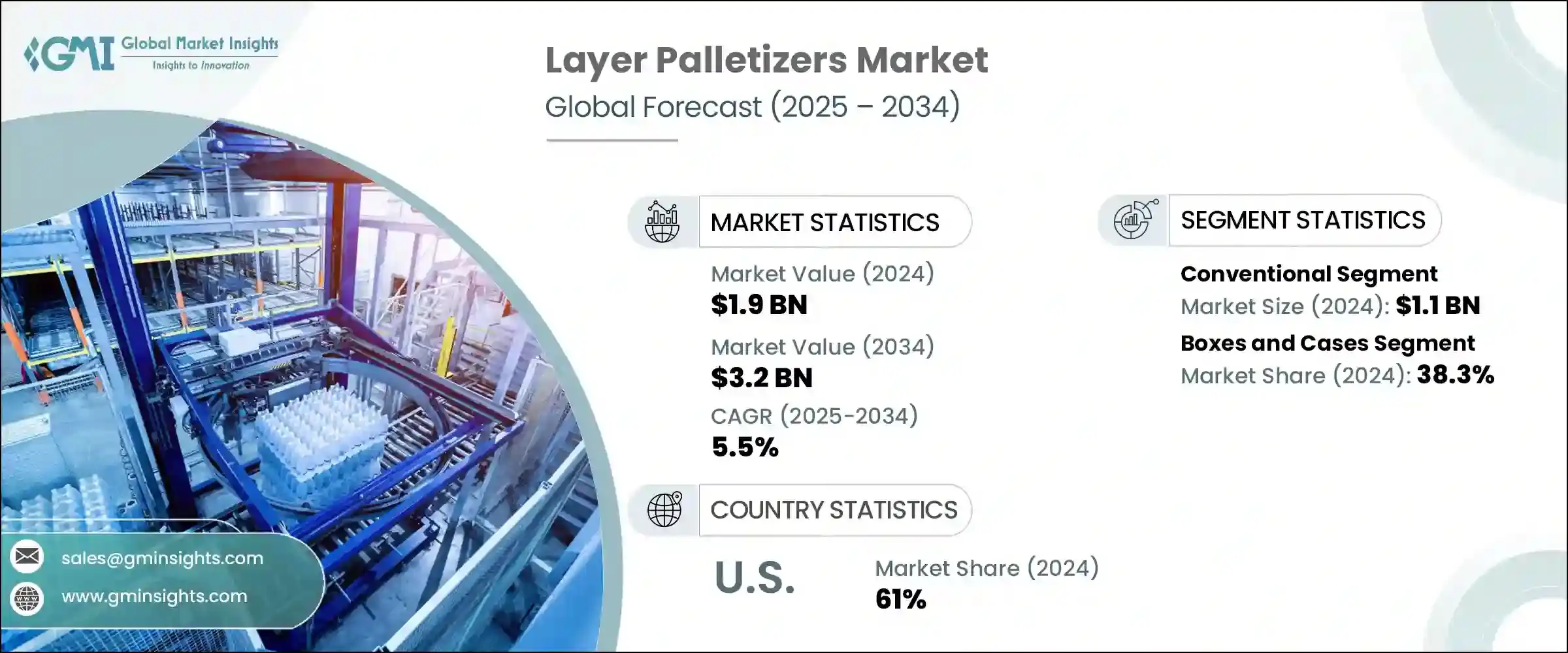
세계의 레이어 팔레타이저 시장 규모는 2024년에 19억 달러에 달하였고, CAGR 5.5%로 성장하여 2034년까지는 32억 달러에 이를 것으로 예측됩니다.
레이어 팔레타이저는 효율적인 운송을 위해 팔레트 상의 제품을 정리하는데 중요한 역할을 하고 있으며, 물류, 공급망, 보관 업무에 널리 응용되고 있습니다.

자동화와 업무효율화에 대한 세계적인 수요 증가가 이 시장의 확대에 박차를 가하고 있습니다. 이러한 기계는 상자나 봉투와 같은 물품을 안정적으로 레이어식으로 적재하는 것으로, 복수의 산업에 걸친 합리적인 유통, 보관, 수송에 필수적인 프로세스입니다. 성장요인으로는 인건비 상승 및 수작업을 최소화하여 산업안전에 중점을 두고 신속하며 오류가 적은 생산 라인의 필요성 등이 있습니다.
| 시장 범위 | |
|---|---|
| 시작연도 | 2024년 |
| 예측연도 | 2025-2034년 |
| 시작금액 | 19억 달러 |
| 예측금액 | 32억 달러 |
| CAGR | 5.5% |
로봇공학, 인공지능(AI), 산업용 사물인터넷(IIoT)을 중심으로 한 기술의 진보가 시장을 추진하고 있습니다.
전통적인 레이어 팔레타이저 부문은 2024년에 11억 달러를 창출했습니다. 기존의 레이어 팔레타이저는 특히 중소규모의 생산시설에 적합하며 다양한 채널의 시장 요구사항을 충족합니다. 이러한 고급 시스템에서 팔레타이징 프로세스를 자동화함으로써 기업은 노동력 부족을 해결하고 가동중지시간을 줄여 섹터를 불문하고 증가하는 수요를 충족시킬 수 있습니다.
2024년 박스 및 케이스 분야의 점유율은 38.3%를 차지했습니다. 레이어 팔레타이저는 제품, 의약품 및 전자상거래와 같은 업계에서 수많은 포장 요구를 충족시켜 줍니다.
미국의 레이어 팔레타이저 시장은 2024년 61%의 점유율을 차지했습니다. 높은 인건비와 팔레타이징과 같은 반복 작업을 위한 노동력 부족이 미국에서 수요를 촉진하는 주요 요인입니다. 제조업, 물류, 그리고 활황을 보이는 전자상거래 부문 전체에서 산업자동화에 대한 강한 뒷받침이 자동 팔레타이징 기술의 보급을 뒷받침하고 있습니다. 미국 기업은 효율성을 높이고 생산량을 늘려 일관된 제품 취급 기준을 유지하기 위해 이러한 시스템에 많은 투자를 하고 있습니다. 또한, 북미 시장 성장은 지속적으로 혁신하고 제품 제공을 강화하는 수많은 유명한 팔레타이저 제조업체와 기술공급자의 존재로 인해 혜택을 누리고 있습니다.
세계의 레이어 팔레타이저 시장을 형성하는 주요 기업은 Korber AG, BW Flexible Systems, Scott Automation, Premier Tech, PHS Innovate, Segbert Palletizing and Automation, COSMAPACK, TRAPO GmbH, Honeywell International Inc, SMB, Brolla, TMI, Mollers Packagce Tectology SpA, Rane 등입니다. 레이어 팔레타이저 업계의 각사는 시장에서의 지위를 굳히기 위해, 혁신과 커스터마이즈에 중점을 두고 다양한 업계의 요구나 생산규모에 맞춘 솔루션을 개발하고 있습니다. OEM 및 포장솔루션 제공업체와의 협업을 통해 기존 라인에 원활하게 통합할 수 있는 종합적인 턴키 시스템을 제공할 수 있습니다.
The Global Layer Palletizers Market was valued at USD 1.9 billion in 2024 and is estimated to grow at a CAGR of 5.5% to reach USD 3.2 billion by 2034. Layer palletizers play a crucial role in organizing products on pallets for efficient transport, with widespread applications across logistics, supply chain, and storage operations. Over recent years, automated palletizing systems have increasingly replaced manual methods in warehouses and manufacturing facilities, driven by their ability to enhance efficiency, reduce product damage, and lessen physical strain on workers.

The growing global demand for automation and operational efficiency is fueling the expansion of this market. These machines carefully stack items such as boxes or bags into neat, stable layers, a process vital for streamlined distribution, storage, and transport across multiple industries. Key market drivers include rising labor expenses, an increased focus on workplace safety by minimizing manual handling, and the need for production lines to operate with greater speed and fewer errors. Manufacturers typically evaluate palletizers based on throughput capacity, adaptability to different product types, facility layout, and compatibility with existing conveyor and packaging systems.
| Market Scope | |
|---|---|
| Start Year | 2024 |
| Forecast Year | 2025-2034 |
| Start Value | $1.9 Billion |
| Forecast Value | $3.2 Billion |
| CAGR | 5.5% |
Technological advancements, especially in robotics, artificial intelligence (AI), and the Industrial Internet of Things (IIoT), are propelling the market forward. Modern layer palletizers boast enhanced flexibility, handling diverse product sizes and shapes while integrating seamlessly into existing production lines. This adaptability ensures manufacturers can meet evolving demands with greater precision and less downtime.
The conventional layer palletizers segment generated USD 1.1 billion in 2024. These systems build pallet loads by stacking goods such as crates and boxes layer by layer, with an upstream conveyor system aligning packages before placement. Conventional palletizers are particularly well-suited to small and medium-sized production facilities and meet the requirements of multi-channel markets. By automating the palletizing process with these advanced systems, businesses can address labor shortages, reduce downtime, and satisfy rising demand across sectors.
In 2024, the boxes and cases segment held a 38.3% share. Layer palletizers are especially effective for handling standardized rectangular or square cartons due to their uniform shape and rigidity. Boxes and cases serve numerous packaging needs across industries such as food and beverages, consumer goods, pharmaceuticals, and e-commerce. Their consistent shape and stackability enable fast, precise, and stable pallet formation, which is essential for efficient supply chains.
U.S. Layer Palletizers Market held a 61% share in 2024. High labor costs combined with workforce shortages for repetitive tasks such as palletizing are major factors driving demand in the U.S. A strong push towards industrial automation across manufacturing, logistics, and the booming e-commerce sector has encouraged widespread adoption of automated palletizing technologies. Companies in the U.S. invest heavily in these systems to boost efficiency, increase output, and maintain consistent product handling standards. Moreover, North America's market growth benefits from the presence of numerous established palletizer manufacturers and technology providers who continuously innovate and enhance product offerings.
Key players shaping the Global Layer Palletizers Market include Korber AG, BW Flexible Systems, Scott Automation, Premier Tech, PHS Innovate, Segbert Palletizing and Automation, COSMAPACK, TRAPO GmbH, Honeywell International Inc, SMB, Brolla, TMI, Mollers Packaging Technology GmbH, Concetti SpA, and Rane. To solidify their market positions, companies in the layer palletizers industry focus heavily on innovation and customization, developing solutions tailored to diverse industry needs and production scales. They invest in integrating cutting-edge robotics, AI, and IIoT capabilities to enhance system flexibility and efficiency. Collaborations with original equipment manufacturers (OEMs) and packaging solution providers allow them to offer comprehensive turnkey systems that seamlessly fit into existing lines. Firms also prioritize expanding their global footprint through strategic partnerships, localized manufacturing, and robust service networks to support customer requirements worldwide.